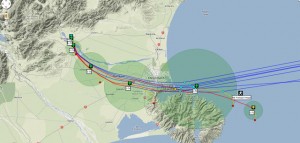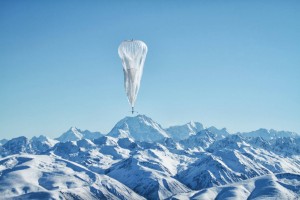Information Technology Google floats Project Loon for balloon-based Internet access
2013/06/19 Twenty kilometres up, slung under balloons from the same company that helped Felix Baumgartner jump from the edge of space last year, a payload of solar panels and wireless antennas is helping Google’s Project Loon bring wireless internet access to the most remote parts of the world. The ultimate goal is to connect the two-thirds of the world’s population that currently has no internet access.
Twenty kilometres up, slung under balloons from the same company that helped Felix Baumgartner jump from the edge of space last year, a payload of solar panels and wireless antennas is helping Google’s Project Loon bring wireless internet access to the most remote parts of the world. The ultimate goal is to connect the two-thirds of the world’s population that currently has no internet access.
Currently being trialled in New Zealand, each balloon delivers a coverage area of 1250 square kilometres as it floats overhead. New Zealanders who want to access the service must have a special antenna fitted to their house that connects to the closest balloon. The signal is then bounced from balloon to balloon, until it joins the internet back on the ground. Solar panels power the balloons’ antennas and communications equipment, storing energy in batteries to keep them working through the night.
Mariya Zheleva, who works on wireless networks for remote developing regions, says the project is inspiring: “I get very excited about solutions like this one that try to escape the conventional understanding for communication infrastructure.”
 Google claims that its setup allows it to deliver “speeds comparable to 3G”, between balloons and the ground. It is unclear how well applications which rely on short communications times, or pings, like VOIP, will work given that the signal must relay through multiple balloons before even reaching to the wider internet.
Google claims that its setup allows it to deliver “speeds comparable to 3G”, between balloons and the ground. It is unclear how well applications which rely on short communications times, or pings, like VOIP, will work given that the signal must relay through multiple balloons before even reaching to the wider internet.
Stephane Boyera, an information and communication technology (ICT) development consultant formerly with the Web Foundation, says he is convinced that Loon is a technically promising solution, but worries that it ignores a huge number of other problems, which may limit its broader impact.
“Connectivity, while being a problem, is not the primary bottleneck in providing ICT services which can improve people’s lives,” says Boyera. The real problem is two-pronged – a lack of content that’s useful to people in developing countries, and the lack of widespread, Wi-Fi compatible devices, he says.
“It is a total myth to imagine a farmer in Mali using Google to find solutions for a disease his tomatoes have. Barriers are just huge: illiteracy, language, ICT training,” Boyera says. The existing web is not that useful to the underprivileged populations of developing countries, and no amount of new connectivity options can fix that, he says.
Boyera also warns that strategies which rely on top-down hardware distribution are historically prone to failure. “I believe that the only scalable option is to focus on what is already available,” he says.
Google Loon is not the first project to attempt to deliver internet access over a wide area but, as the project name suggests, it is probably the kookiest.
Google will rely on weather prediction to keep its balloons in the right place, moving them up and down to take advantage of different air currents. “Project Loon uses software algorithms to determine where its balloons need to go, then moves each one into a layer of wind blowing in the right direction,” Google announced. “By moving with the wind, the balloons can be arranged to form one large communications network.”
Zheleva warns that a balloon-based system faces some fairly unique technical challenges. “Stabilisation of the balloons is of great importance, since a slight shift of the balloon due to wind can result in major shift of the coverage area on the ground,” she says.
Flight time is another issue. The Raven Aerostar balloons Google is using typically have a maximum flight time of 55 days, meaning that the floating internet links will need to be either replaced on a regular basis, or replenished with helium while aloft. Google claims that its tweaked design can stay aloft for more than 100 days.
A similar project called Antarctic Broadband is planning to use small, cheap satellites to bring steady, reliable internet to the continent. Currently researchers there must rely on signals from geostationary satellites, which are above the equator, meaning their signals barely reach the edges of the Antarctic.
Unlike Project Loon, Antarctic Broadband will not connect users to a nearby internet relay through its satellites, but to dedicated ground stations in western Australia and South America.
See also: Project Loon on Google+
Syndicated content: Hal Hodson, New Scientist
Welcome to SUV System Ltd!
SUV System Ltd is ISO 90012008 Certified electronics distributor with 10 years of experiences.
We have built up long term business relationship with about many companies which are stockers and authorized agents. we have a steady and reliable supply to meet customer's demands to the greatest extent .Confidently, we are able to lower your cost and support your business with our years of professional service.
SUV System Ltd is Electronic Components Distributor Supplies,Find Quality Electronic Components Supplies Products IC(Integrated Circuits),Connectors,Capacitor,Resistors,Diodes,Transistors,LED at Suvsystem.com. Sourcing Other Energy, Environment, Excess Inventory Products from Manufacturers and Suppliers at Suvsystem.com
Electronic Components distributor:http://www.suvsystem.com
Connectors Distributor:http://www.suvsystem.com/l/Connectors-1.html
IC Distributor:http://www.suvsystem.com/l/IC(Integrated-Circuits)-1.html
LED Distributor:http://www.suvsystem.com/l/LED-1.html
Capacitor Distributor:http://www.suvsystem.com/l/Capacitor-1.html
Transistor Distributor:http://www.suvsystem.com/l/Transistors-1.html
Resistor Distributor:http://www.suvsystem.com/l/Resistors-1.html
Diode Distributor:http://www.suvsystem.com/l/Diodes-1.html
SUV System Ltd insists on the managing faith ofsincereness,speciality,foresight, win-win,so we build up stable-relationship customers located all over the world, including the States, Europe, Argentina, UAE, Malaysia, Australia,and India etc
we are focus on the following fields,and hope we can help you.
Transistors Fairchild Semiconductor Transistors Voltage Regulators Transistors TOSHIBA Transistors NEC Transistors DIODES Transistors NEC Diodes components Thin Film Resistors YAGEO Resistors Resistor Networks ST Transistors INTERSIL IC Digital Transistors Freescale Semiconductor Chip Fuses NS IC Diodes chip Filter saws IR transistor Metal Can Packages Transistors Multi-units Transistors Switching Diodes PANASONIC Ligitek LED Connectors Discrete Semiconductor Transistors Diodes Inc Infineon Technologies Transistors High Precision Resistors BB IC INFLNEON Diodes LED Texas Instruments(TI) IC Transistors Freescale ON Transistors ALTERA IC Industrial IC Low Ohmic Resistors Military IC
http://www.suvsystem.com/a/3835.aspx
没有评论:
发表评论